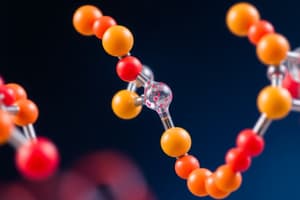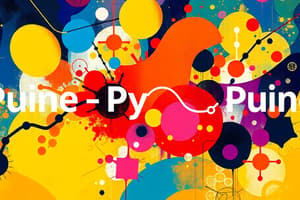Podcast
Questions and Answers
In the de novo synthesis of purine nucleotides, what is the source of the carbon atoms that become C2 and C8 in the purine ring?
In the de novo synthesis of purine nucleotides, what is the source of the carbon atoms that become C2 and C8 in the purine ring?
- Glycine
- Aspartic acid
- Tetrahydrofolate (THF) (correct)
- Carbon dioxide
Which of the following enzymatic activities is directly inhibited by the drug allopurinol?
Which of the following enzymatic activities is directly inhibited by the drug allopurinol?
- Xanthine oxidase (correct)
- Hypoxanthine-guanine phosphoribosyltransferase (HGPRT)
- Thymidylate synthase
- Adenosine deaminase
During purine nucleotide synthesis, which step is considered the committed step, regulating the overall pathway?
During purine nucleotide synthesis, which step is considered the committed step, regulating the overall pathway?
- Formation of inosine monophosphate (IMP)
- Addition of a formyl group
- Reaction catalyzed by Gln-PRPP amidotransferase (correct)
- Activation of ribose-5-phosphate by ATP
In what way tetrahydrofolate (THF) acts as a critical carrier in one-carbon transfer reactions during purine synthesis?
In what way tetrahydrofolate (THF) acts as a critical carrier in one-carbon transfer reactions during purine synthesis?
What is the energetic cost, in terms of ATP equivalents, for the de novo synthesis of GMP from its precursors?
What is the energetic cost, in terms of ATP equivalents, for the de novo synthesis of GMP from its precursors?
Which of the following best describes the role of the salvage pathways in nucleotide biosynthesis?
Which of the following best describes the role of the salvage pathways in nucleotide biosynthesis?
What is the consequence of a genetic deficiency in hypoxanthine-guanine phosphoribosyltransferase (HGPRT), as observed in Lesch-Nyhan syndrome?
What is the consequence of a genetic deficiency in hypoxanthine-guanine phosphoribosyltransferase (HGPRT), as observed in Lesch-Nyhan syndrome?
What is the primary fate of ingested nitrogenous bases that are not incorporated into nucleic acids?
What is the primary fate of ingested nitrogenous bases that are not incorporated into nucleic acids?
Which of the following is the correct order of steps in purine biosynthesis?
Which of the following is the correct order of steps in purine biosynthesis?
Which of the following molecules directly provides the nitrogen atom at the N1 position of the purine ring?
Which of the following molecules directly provides the nitrogen atom at the N1 position of the purine ring?
What is the immediate precursor for dTMP synthesis?
What is the immediate precursor for dTMP synthesis?
Why is the inhibition of thymidylate synthase (TS) an effective strategy in cancer chemotherapy?
Why is the inhibition of thymidylate synthase (TS) an effective strategy in cancer chemotherapy?
What is the role of ribonucleotide reductase (RNR) in nucleotide metabolism?
What is the role of ribonucleotide reductase (RNR) in nucleotide metabolism?
What is the underlying biochemical principle behind the use of fluoro-substituted analogs as therapeutic agents?
What is the underlying biochemical principle behind the use of fluoro-substituted analogs as therapeutic agents?
How does the regulation of purine biosynthesis respond to high levels of ATP and GTP within the cell?
How does the regulation of purine biosynthesis respond to high levels of ATP and GTP within the cell?
In pyrimidine biosynthesis, what is the committed step and what enzyme catalyzes it?
In pyrimidine biosynthesis, what is the committed step and what enzyme catalyzes it?
What specific metabolic effects would result from the use of a glutamine analog that effectively inhibits glutamine amidotransferases?
What specific metabolic effects would result from the use of a glutamine analog that effectively inhibits glutamine amidotransferases?
How do feedback mechanisms regulate nucleotide biosynthesis to maintain balanced levels within the cell?
How do feedback mechanisms regulate nucleotide biosynthesis to maintain balanced levels within the cell?
Which of the following is the correct order of enzyme activities required to convert UMP to dTMP?
Which of the following is the correct order of enzyme activities required to convert UMP to dTMP?
A cell has abundant ATP, but is deficient in GTP. Which of the following regulatory mechanisms is most likely to be activated?
A cell has abundant ATP, but is deficient in GTP. Which of the following regulatory mechanisms is most likely to be activated?
What is the role of tetrahydrofolate in the synthesis of dTMP, and how it that role linked to cancer therapy?
What is the role of tetrahydrofolate in the synthesis of dTMP, and how it that role linked to cancer therapy?
What property of fluoro-substituted uracil makes it an effective anti-cancer drug?
What property of fluoro-substituted uracil makes it an effective anti-cancer drug?
How does the allosteric regulation of ribonucleotide reductase (RNR) balance the pool of deoxyribonucleotides needed for DNA synthesis?
How does the allosteric regulation of ribonucleotide reductase (RNR) balance the pool of deoxyribonucleotides needed for DNA synthesis?
If a cell is treated with a drug that inhibits the conversion of IMP to GMP, which of the following is most likely to occur?
If a cell is treated with a drug that inhibits the conversion of IMP to GMP, which of the following is most likely to occur?
What is the significance of having 'anaplerotic' pathways associated with nucleotide metabolism?
What is the significance of having 'anaplerotic' pathways associated with nucleotide metabolism?
In the context of purine degradation and uric acid formation, which statement accurately describes the role of xanthine oxidase?
In the context of purine degradation and uric acid formation, which statement accurately describes the role of xanthine oxidase?
Lack of adenosine deaminase (ADA) leads to severe combined immunodeficiency syndrome (SCID). Which statement explains the molecular basis for imunodeficiency?
Lack of adenosine deaminase (ADA) leads to severe combined immunodeficiency syndrome (SCID). Which statement explains the molecular basis for imunodeficiency?
How does the de novo synthetic pathway contribute to the overall pool of nucleotides compared to dietary intake?
How does the de novo synthetic pathway contribute to the overall pool of nucleotides compared to dietary intake?
Which of the following metabolic conversions are unique to pyrimidine nucleotide synthesis (as opposed to purine synthesis)?
Which of the following metabolic conversions are unique to pyrimidine nucleotide synthesis (as opposed to purine synthesis)?
Which of the following statements accurately describes the regulation of pyrimidine synthesis?
Which of the following statements accurately describes the regulation of pyrimidine synthesis?
Why is it important that cells have mechanisms to degrade nucleotides?
Why is it important that cells have mechanisms to degrade nucleotides?
What is the role of the metal cofactor (Mo) in xanthine oxidase?
What is the role of the metal cofactor (Mo) in xanthine oxidase?
Considering the role that ribonucleotide reductase plays in DNA synthesis, how would inhibiting this enzyme with hydroxyurea affect a cell?
Considering the role that ribonucleotide reductase plays in DNA synthesis, how would inhibiting this enzyme with hydroxyurea affect a cell?
Which mechanism primarily accounts for the difference in pyrimidine catabolism compared to purine catabolism?
Which mechanism primarily accounts for the difference in pyrimidine catabolism compared to purine catabolism?
How do sulfonamide drugs inhibit bacterial growth, specifically targeting nucleotide synthesis?
How do sulfonamide drugs inhibit bacterial growth, specifically targeting nucleotide synthesis?
Which statement concerning the general mechanisms for regulating metabolic pathways is TRUE?
Which statement concerning the general mechanisms for regulating metabolic pathways is TRUE?
Flashcards
De novo synthesis
De novo synthesis
Synthesis of nucleotide bases using metabolic precursors.
Salvage synthesis
Salvage synthesis
Recycling purines and pyrimidines to create nucleotide bases.
Inosine monophosphate (IMP)
Inosine monophosphate (IMP)
The initial purine derivative synthesized in purine synthesis.
Gln-PRPP amidotransferase
Gln-PRPP amidotransferase
Signup and view all the flashcards
Tetrahydrofolate
Tetrahydrofolate
Signup and view all the flashcards
Xanthine oxidase
Xanthine oxidase
Signup and view all the flashcards
Gout
Gout
Signup and view all the flashcards
Anaplerotic
Anaplerotic
Signup and view all the flashcards
Lesch-Nyhan syndrome
Lesch-Nyhan syndrome
Signup and view all the flashcards
ATCase
ATCase
Signup and view all the flashcards
CTP synthetase
CTP synthetase
Signup and view all the flashcards
Thymidylate Synthase
Thymidylate Synthase
Signup and view all the flashcards
Xanthine oxidase
Xanthine oxidase
Signup and view all the flashcards
Ribonucleotide Reductase
Ribonucleotide Reductase
Signup and view all the flashcards
Study Notes
Overview of Nucleotide Synthesis and Degradation
- Most organisms synthesize nucleotides through two main pathways:
- De novo synthesis: Uses metabolic precursors.
- Salvage synthesis: Recycles purines and pyrimidines.
- Nitrogenous bases are not catabolized for energy; only the ribose ring undergoes catabolism.
Purine Synthesis
- N-1 atom comes from aspartic acid.
- N-3 and N-9 atoms come from glutamine.
- C-4, C-5, and N-7 atoms come from glycine.
- C-6 atom comes from CO2.
- C-2 and C-8 atoms come from THF (tetrahydrofolate, a one-carbon unit carrier).
- The purine ring is constructed on a ribose-5-phosphate platform.
- Inosine monophosphate (IMP) is the first purine derivative formed, as ribonucleotides not free bases.
- Ring system atoms are added successively to ribose-5-phosphate.
- R5P (ribose-5-phosphate) activation involves PPi transfer from ATP, to carbon-1 generating 5-phosphoribosyl-α-pyrophosphate (PRPP).
- PRPP is the limiting substrate.
- Step 2, the production of phosphoribosyl-β-amine, is the committed step in purine biosynthesis.
- GMP and AMP are synthesized from IMP in two steps.
- AMP synthesis requires 8 ATP equivalents, and GMP requires 6 ATP equivalents.
- First step involves activation of ribose-5-P by ATP-dependent PPi addition, forming 5-phosphoribosyl-1-pyrophosphate (PRPP).
- Glycine carboxyl condenses with amine of 5-phosphoribosyl-β-amine.
- Glycine carboxyl is activated by phosphorylation from ATP.
- Amine attacks the glycine carboxyl.
- The resulting product is glycinamide ribonucleotide (GAR).
- Formyl group of N10-formyl-THF is transferred to GAR's free amino group, producing α-N-formylglycinamide ribonucleotide.
- C-4 carbonyl forms a P-ester with phosphate from ATP.
- Active NH3 attacks C-4 to form formylglycinamidine ribonucleotide (FGAM).
- ATP activates the formyl group through phosphorylation, facilitating attack by N.
- The reaction leads to carboxyaminoimidazole ribonucleotide (CAIR) formation.
- Deprotonation of Asp-CH2 then leads to fumarate cleavage.
- Another one-carbon addition occurs using N-formyl-THF.
- The amino group attacks the formyl group closing the second ring.
Tetrahydrofolate
- Folic acid, a B vitamin in plants, fruits, yeast, and liver, named from folium (Latin for "leaf").
- Folates accept/donate one-carbon units for all carbon oxidation levels except CO2 (biotin is used).
- The active form of folate is tetrahydrofolate
Regulation of Purine Biosynthesis
- Regulation occurs through feedback inhibition and allosteric activation by α-PRPP.
- Step 1, feedback inhibition occurs by GDP and ADP.
- Step 2 feedback inhibition occurs by GMP, GDP, AMP, ADP, and ATP.
- Allosteric activation is achieved via α-PRPP.
- Fate of IMP is determined by GMP and AMP levels, leading to balanced nucleotide synthesis.
- GMP synthesis increases with rising ATP levels.
- AMP synthesis increases with rising GTP levels.
- GTP drives AMP biosynthesis, and ATP drives GMP biosynthesis.
- NMP is converted to NDP and then to NTP.
- Adenylate kinase facilitates AMP + ATP conversion to 2 ADP.
- Guanylate kinase facilitates GMP + ATP conversion to GDP + ADP.
- Nucleoside diphosphate kinase facilitates ATP + GDP conversion to ADP + GTP.
Purine Salvage
- Salvage pathways convert free nitrogenous bases to corresponding nucleotides.
- Phosphoribosyltransferase is involved.
- PPi drives the reaction forward through hydrolysis.
- APRT (Adenine phosphoribosyltransferase) exists.
- HGPRT (Hypoxanthine-guanine phosphoribosyltransferase).
Lesch-Nyhan Syndrome
- It is characterized by a buildup of uric acid.
- It causes hyperuricemia and hyperuricosuria.
- It is associated with severe gout and kidney problems.
- Neurological signs include poor muscle control and mental retardation.
Purine Degradation
- Nucleic acids are degraded by nucleases and phosphodiesterases into nucleotides.
- Further degradation results in ribose-1-phosphate and uric acid.
- Dietary nucleic acids are not readily incorporated into cellular nucleic acids.
- Most purines are from de novo synthetic pathways.
- Ingested bases are excreted as uric acid.
Xanthine Oxidase
- Xanthine oxidase is a mini electron-transport protein.
- Purine bases are degraded to xanthine, which is then oxidized to uric acid.
- Xanthine oxidase contains electron transfer prosthetic groups.
- The active site contains a molybdopterin complex with Mo (VI) and Mo (IV) oxidation states.
- The final electron acceptor is O2.
- It is found in large amounts in liver and milk.
Gout
- Gout stems from excess uric acid.
- Allopurinol, a hypoxanthine analog, is a xanthine oxidase inhibitor.
- Allopurinol binds tightly to xanthine oxidase, preventing the uric acid formation.
- Hypoxanthine and xanthine do not accumulate to harmful levels because they are more soluble.
Purine Nucleotide Cycle & Uric Acid Fate
- The purine nucleotide cycle is anaplerotic.
- It replenishes fumarate in the TCA cycle using aspartate.
- Significant in skeletal muscle deficient in typical anaplerotic enzymes.
- Fate of uric acid is oxidation and excretion.
- Gout is characterized by elevated uric acid levels.
- Symptoms include arthritis, pain, and joint inflammation.
- May result in kidney stones.
Adenosine Deaminase Deficiency
- SCID symptoms relate to diminished immune responses.
- 30% of SCID patients are deficient in adenosine deaminase.
- Deoxyadenosine is not deaminated to deoxyinosine due to this ABSENCE.
Pyrimidine Synthesis
- Pyrimidine ring is assembled before attachment to ribose-5-phosphate.
- Carbamoyl phosphate synthetase II is the committed step.
- Rxns 1-3 are on one polypeptide
- Rxns 5 & 6 are on one
- 2 ATP are required for orotate production from carbamoyl-Asp
- Three ATPs are required to convert dihydroorotate (DHO) to orotate.
UTP to CTP Conversion and Regulation
- UMP is converted to UTP and then to CTP.
- CTP is formed through amination of UTP by CTP synthetase.
- Feedback inhibition differs in bacteria and animals; indicates energy and purine sufficiency.
Pyrimidine Degradation
- Degradation occurs into β-alanine (C & U), β-aminoisobutyric acid (T), NH4+, and CO2.
- Pyrimidines in nucleosides can be reused, but free pyrimidines cannot be salvaged, only degraded.
Ribonucleotide Reductase (RNR)
- dNDPs are synthesized from NDPs.
- They are synthesized by the reduction at the 2’-OH position and not by synthesis from deoxyribose precursors.
- It has a heterotetramer (α2β2) structure, forming R1 and R2 subunits.
- NADPH donates electrons, which go to thioredoxin reductase, thioredoxin, and ribonucleotide reductase.
- Substrates for RNR are CDP, UDP, GDP, and ADP to form their deoxy counterparts
Control of Deoxyribonucleotide Biosynthesis
- RNR activity controls appropriate dNTP balance for DNA synthesis.
- ATP activates the enzyme.
- dATP inactivates the enzyme.
- In specificity site S, ATP favors CDP or UDP in catalytic site C, and dTTP favors GDP or ADP.
Thymine Nucleotides
- Both dUDP and dCDP are usable to make dUMP (the immediate precursor for dTMP synthesis).
- dCMP deaminase marks the second point of regulation in dNTP biosynthesis.
- The thymidylate synthase catalyzes the synthesis of dTMP from dUMP.
- Methylation occurs at the 5-position.
- N5, N10-methylene-THF acts as the methyl donor.
- 5,10-methylenetetrahydrofolate + dUMP = dihydrofolate + dTMP.
- Many cancers utilize inhibitors of TS to treat them
Studying That Suits You
Use AI to generate personalized quizzes and flashcards to suit your learning preferences.




